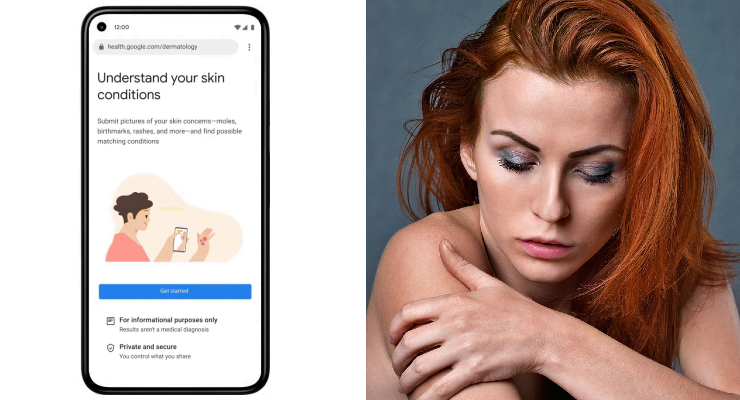Charles Sternberg, Assistant Editor05.25.21
Earlier this week, Google shared a preview of an AI-powered dermatology assist tool that helps people understand what’s going on with issues related to their skin, hair and nails.
Using many of the same techniques that detect diabetic eye disease or lung cancer in CT scans, this tool identifies dermatologic issues — like a rash — using a phone’s camera.
Google says it sees almost ten billion Google Searches related to skin, nail and hair issues each year. Two billion people worldwide suffer from dermatologic issues, but there’s a global shortage of specialists. While many people’s first step involves going to a Google Search bar, it can be difficult to describe what you’re seeing on your skin through words alone.
Google’s AI-powered dermatology assist tool is a web-based application that the company hopes to launch as a pilot later this year, to make it easier to figure out what might be going on with skin.
How It Works
Once the tool is launched, simply use a phone camera to take three images of the skin, hair or nail concern from different angles. The user will then be asked questions about their skin type, how long they’ve had the issue and other symptoms that help the tool narrow down the possibilities. The AI model analyzes this information and draws from its knowledge of 288 conditions to give a list of possible matching conditions that the user can then research further.
For each matching condition, the tool will show dermatologist-reviewed information and answers to commonly asked questions, along with similar matching images from the web.
The tool is not intended to provide a diagnosis nor be a substitute for medical advice as many conditions require clinician review, in-person examination, or additional testing like a biopsy. Rather Google hopes it gives access to authoritative information so people can make more informed decisions about their next steps.
The tool is the culmination of over three years of machine learning research and product development. To date, Google has published several peer-reviewed papers that validate its AI model and more are in the works.
Recently, the AI model that powers the tool successfully passed clinical validation, and the tool has been CE marked as a Class I medical device in the EU. In the coming months, Google plans to build on this work so more people can use this tool to answer questions about common skin issues.
Using many of the same techniques that detect diabetic eye disease or lung cancer in CT scans, this tool identifies dermatologic issues — like a rash — using a phone’s camera.
Google says it sees almost ten billion Google Searches related to skin, nail and hair issues each year. Two billion people worldwide suffer from dermatologic issues, but there’s a global shortage of specialists. While many people’s first step involves going to a Google Search bar, it can be difficult to describe what you’re seeing on your skin through words alone.
Google’s AI-powered dermatology assist tool is a web-based application that the company hopes to launch as a pilot later this year, to make it easier to figure out what might be going on with skin.
How It Works
Once the tool is launched, simply use a phone camera to take three images of the skin, hair or nail concern from different angles. The user will then be asked questions about their skin type, how long they’ve had the issue and other symptoms that help the tool narrow down the possibilities. The AI model analyzes this information and draws from its knowledge of 288 conditions to give a list of possible matching conditions that the user can then research further.
For each matching condition, the tool will show dermatologist-reviewed information and answers to commonly asked questions, along with similar matching images from the web.
The tool is not intended to provide a diagnosis nor be a substitute for medical advice as many conditions require clinician review, in-person examination, or additional testing like a biopsy. Rather Google hopes it gives access to authoritative information so people can make more informed decisions about their next steps.
The tool is the culmination of over three years of machine learning research and product development. To date, Google has published several peer-reviewed papers that validate its AI model and more are in the works.
Recently, the AI model that powers the tool successfully passed clinical validation, and the tool has been CE marked as a Class I medical device in the EU. In the coming months, Google plans to build on this work so more people can use this tool to answer questions about common skin issues.




























